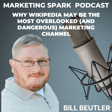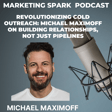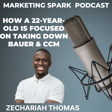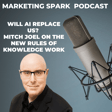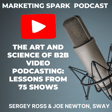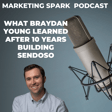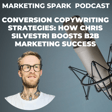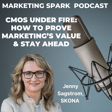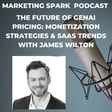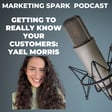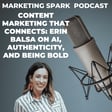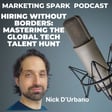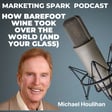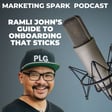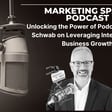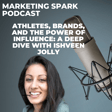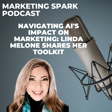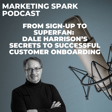Become a Creator today!Start creating today - Share your story with the world!
Start for free
00:00:00
00:00:01

Who gives a crap about email marketing: Jules Dan
The “unsubscribe” notification is painful.
Someone wants to end a relationship.
They want you out of their lives.
It’s not them, it’s you…and your newsletter.
But is the unsubscribe really that bad?
Should marketers, in fact, celebrate unsubscribes?
When you step back, someone disconnecting from a newsletter means they’re not your target audience.
The effort invested to create a newsletter isn’t resonating with them.
So, it’s perfectly fine for both sides to move on.
On the Marketing Side podcast, Jules Dan said it’s more important to focus on the people who want your email marketing.
“I sometimes encourage people to unsubscribe.”
Transcript
The Power of Email Marketing
00:00:05
Speaker
It's Mark Evans, and you're listening to Marketing Spark. Email marketing is alive, well, and thriving. 89% of marketers use email as the primary channel for generating leads. And 59% of B2B marketers prefer email for lead generation. As well, email marketing generates $42 of ROI for every dollar spent. Today, I'm talking to Jules Dan, an email copywriter who helps coaches and consultants convert more leads into customers
00:00:35
Speaker
Welcome to Marketing Spark. Mark, it's a pleasure to be on the show and thanks for having me on. Have you had an Aussie before on the show? You are the second one I've actually had on the show and not the second marketer. So you don't get that honor, but it's very exciting to have someone probably across the world on the podcast. This is a global podcast, by the way. So, you know, I try to reach out to all continents. An obvious first question.
Email's Unique Advantages
00:01:00
Speaker
Amid the vast digital buffet of marketing channels,
00:01:05
Speaker
Why is email so powerful? Why does it work so well? And as important, what's behind the stain power? I mean, every time you say or think that email is going to disappear because of Slack or text messaging or another medium, it keeps on going. Provide an explanation about why email is still around and still the marketing channel for many companies.
00:01:28
Speaker
Of course, I've got a little story to illustrate this point and it's really dear to my heart because when I first started this game, I was doing a lot of Facebook ads and chat bots at the time, so BOTS. And everyone knows how at the time in 2018, if you were dabbling in chat bots, how Facebook would just change the rules all the time. And I remember I created this brilliant campaign where I just sucked out leads for this client. And then overnight, my whole chat bot sequence I'd spent
00:01:56
Speaker
20, 30 hours building was flagged as breaching the terms of service. There was a critical sort of step that I couldn't do anymore and it was just all gone. I realized at that point I had no control over that media. I don't think that's a really good spot to be in, especially if you're being a freelance like myself. I don't want to be walking on eggshells all the time.
Email Habits and Effectiveness
00:02:19
Speaker
when I'm trying to work with clients and that's when I swapped to focusing on email because you own it. There are a few rules you have to go around. Obviously, you can't spam stuff, but for the most part, you own the asset. It's not regulated as hard as Facebook and it's super easy to just send out emails
00:02:41
Speaker
to customers just to follow up with them to when they give you the email address, it's easy to break down objections. It's one of my favorite medias. I know you had a few different questions there. What was the second part of your question there, Mark? Well, I'm just wondering why email has staying power. Every time you think that we're at the end of email or email is going to lose of effectiveness or that marketers aren't going to use email as often, it keeps on going. Can you explain that?
00:03:08
Speaker
It has something to do with, I don't know why, but everyone just loves checking their emails. Something to do with just like, oh, I've got this notification, I have to open it. And I don't know what the statistics are, but if you check out HubSpot, it's something crazy. So many people check their emails. So the fact that they're checking it and then we're able to at least deliver a message to that medium, to that media, I think it's really powerful.
00:03:34
Speaker
I remember when the blackberry first came out and the idea of mobile email was this amazing thing. It started this whole craze about people staring down at their devices all the time because the ability to get email on the road was astounding and now we check it wherever and whenever I guess it's a it's an addiction for many people.
00:03:55
Speaker
Over the last year when we haven't been able to go to conferences and we haven't been able to see people in person although in Australia the situation is completely different things seem to be pretty open down there email.
Keys to Successful Email Campaigns
00:04:05
Speaker
Along with content marketing have been leveraged by marketers to the answer i suspect the most people's inboxes are overflowing with email and the question to you is a mid the tsunami of email and the fact that we're all leveraging it so.
00:04:20
Speaker
Enthusiastically what are the keys to email marketing success i realize that is a loaded question and there's lots of ways you can go here but what are best practices to breaking through when someone opens their inbox and there's dozens of emails waiting for them.
00:04:37
Speaker
So the whole point, it's like go back to that no like trust factor and setting the stage and the agenda early on. So when someone opt-in for your freebie, you want to be getting them to consume your freebie because that's, I know it's really hard to do because not many people ever do that, but
00:04:54
Speaker
You know, in that first email, you want to get them to consume it. So having that link at the top and then you want to giving some, sending some expectations. Like I'm going to be emailing you a few times a week. Something that I like to do with my clients is that, um, over the next few days, you're going to hear some stories about pain point, pain point, pain point stuff that are really dear to that market market. And the PS I'll be like to help you cut through the clutter, look out for JD as like a prefix. And that's, and that way, you know, it's a real email from me.
00:05:22
Speaker
Those are just some things that I like to do to set the stage really early on and do not do what a lot of people on LinkedIn do is where you add someone and then they automatically add them to your email list. That's one of the worst things you could do.
Avoiding Common Email Mistakes
00:05:38
Speaker
Yeah, it's a good segue into my next question, which is really about email marketing mistakes. And I think you and I see them every day when an email comes into your inbox and you look at it and go, Oh my God, I can't believe the marketer actually did something like that. Can you highlight the things that email marketers shouldn't do? And must be some obvious things that set off red flags and almost cause you to
00:06:00
Speaker
respond to the marketer and say, Listen, I got to tell you something. That email you sent was just terrible. And can I please help you do marketing better? What are some of those mistakes that you run into? Okay, so would you be interested more and say like the copy or just sort of sending elements that land in the inbox? Well,
00:06:19
Speaker
I think both. I mean, I think there are mistakes that marketers make when it comes to best practices as far as deliverability, and there are mistakes that marketers make when it comes to content. So maybe you can touch upon both. Yeah, we'll start on content first, because I think you're going to nail that first before you worry about deliverability.
00:06:37
Speaker
One of the biggest mistakes I had when I first started writing email copy was that my attention was scattered everywhere. There wasn't an agenda. There wasn't one thing to focus on. What happens is that people go on tangents a lot when they write emails. Either they'll tell a story or they want to promote more than one thing and people are confused. People are distracted.
00:07:05
Speaker
If you can keep the premise, but when you start writing email, I always ask the question, what's my objective? And that just makes it a lot clearer. So I don't go off on these side tangents and look as best you can keep it to one call to action and one link.
00:07:21
Speaker
Because we could spend an hour talking about how do we structure a story? What are some persuasive tactics? But if you can just focus on one thing, one call to action, if you feel like you're going off on a tangent, reread it after you've finished out loud and that always helps. That's a good starting point for the content. For deliverability, I see this a lot, Mark, and it's really simple things, but
00:07:49
Speaker
I asked my clients, can you change this? And for some reason, they don't want to because it takes away from their branding. But you look at the top email marketers and they're always in my inbox and because they've got a plain email, they don't have social media buttons down the bottom. They don't have a huge banner.
00:08:06
Speaker
They don't have a whole bunch of images and links going everywhere. It's a really clean email. Like it's just come from a friend. And that's just what I've noticed. And when I send my emails out, generally they hit the real inbox. Sometimes they hit the promo box, but those are my two tips for content and deliverability.
Integrating Email with Content Marketing
00:08:25
Speaker
As I mentioned earlier, B2B marketers have been leveraging content marketing and email marketing over the past year. So one of the things that I'm interested in is getting some guidance or advice on how do you marry the two? How do you leverage the power of content marketing, which engages and educates and entertains with the distribution power of email marketing? What are best practices when it comes to getting those two things to work together?
00:08:54
Speaker
So when you're saying distribution, like you want to sort of educate and give them some value, but you also want to sell to them as well. Is that what you're asking? Not so much selling, but the idea is that marketers put a lot of time and effort into creating high quality content, ostensibly high quality content. Although you could argue that there's a lot of content.
00:09:13
Speaker
that isn't high quality. And they leverage social media, Facebook, LinkedIn, Twitter to get the word out. But email is still a great distribution vehicle to get content into people's hands. What are the best practices about using email for content marketing distribution to make sure that people see your email, see the content that you've actually produced?
00:09:34
Speaker
I guess we could use the same principle that I use for a lot of my sales emails and that's excitement but not fulfillment, if that makes sense. You want to get people, you want to tease people, you want to get them hot and heavy and excited. A great way to do these are using John Carlton's bullets. If you haven't checked that out, he teaches how to write bullets. He's a really good copywriter and it just
00:10:01
Speaker
absolutely teases the crap out of someone who's interested in that content. Man, I see some long emails. If you're just sending someone to a blog post or a video or something that's a piece of content, it's just a tease. The email shouldn't be longer than say 150, 250 words. Maybe a little bit of a story, how you discovered it and then you leave a bit of a cliffhanger on the end and that cliffhanger is click the link.
00:10:26
Speaker
Maybe you talk a little bit about bullets like is that just simply using bullets to break up copy to make it more accessible user friendly because when I see a wall of text, in many cases, the first thing that I think of is this is going to be a lot of work. This is going to take some effort and I don't want to work. I've got so much to do. I've only got so much time. Does bullets sort of trick your mind into thinking that it's going to be an easy read?
00:10:49
Speaker
Oh, I like to think so. The bullets are just supposed to be like getting you really excited to click the link. If the one thing I always try and avoid in my bullets is learn the top five, because as soon as you say learn, it's like, oh, there's work involved. That's something I learned from my mentor. So if you can make like discover the hidden secrets, the secret tool to take away these little just
00:11:17
Speaker
action words and curiosity-packed words that might help. I wish I had some examples in front of me to tell your audience, Mark, but does that answer your question? It does. It does. And I think it comes down to the idea that email, like anything, has to be user-friendly. It has to be
00:11:32
Speaker
accessible and like any form of digital marketing, it really can't involve a lot of work because I always suggest that people are lazy and they don't want to work. They want to be spoon fed in
Personalization and Segmentation in Email
00:11:44
Speaker
many cases. One of the topics that I wanted to touch upon is the idea of personalization.
00:11:49
Speaker
One of my client's coherent path helps retailers create what they call content diets. Customers receive emails that feature content that is relevant and interesting, not only encourages you to buy more of what you've already purchased, but explore different categories.
00:12:05
Speaker
So i wanted to get your take on email marketing personalization because a lot of marketers it's. It's one and done you blast everybody or maybe you create a few variations but i'm not so sure that there's a lot of sophistication when it comes to email marketing any thoughts about that.
00:12:22
Speaker
When you say personalization, that goes down into segmentation. Is that what you're asking? Exactly. The idea that the email that I get is going to be different, maybe dramatically different from the email you're going to get because you have different interests than I do. You buy different things or download different things than I do. I'll give you my experience. I know there are some people who'd be like,
00:12:44
Speaker
VP of marketing and they've got 10 different segmentations because they've got a huge company and they've got lots of data. For me, I just work with clients who've got small issue lists, one and a half to 3,000 people. Usually what I recommend is to have a buyers list and a non-buyers list. The reason why we do that is if you want to test a little offer,
00:13:05
Speaker
It's better to test it to the buyers first than it is to... I know we're talking about content marketing before. Yeah, I've always found that when you want to test stuff, it's good to send it to the buyers. That's as sophisticated as I get. I know I didn't quite answer your question mark, but if you're going to have some kind of segmentation, you don't want to get overwhelmed, I would start there.
00:13:27
Speaker
I think for small customers, for customers that haven't got extensive email lists, that makes a lot of sense because you don't want to slice and dice a relatively small database. It probably causes more work than it's worth, and you probably don't get the results that you expect. But I do believe that people are expecting email to be more personalized, to be more relevant, to be more about what their interests are, and that if you're just doing one email for a vast audience, that's not going to work. It simply won't resonate.
00:13:55
Speaker
Can I counter you on that because the hard part is showing up and some people are afraid to show up. I don't know why, but there's this fear of sending out more than one email a week or God forbid, two emails per week. If you can get to that stage first, one or two emails a week,
00:14:17
Speaker
Sure. Let's explore segmentation and how we can optimize deliverability. But I think the habit of showing up, your audience knows on this day, Mark sends an email on Tuesdays and Fridays. Then that's when you can get fancy with segmentation stuff. But if you want to talk about segmentations, probably not the right person to talk to. But if you want to learn about emails that sell, let's ask about that. Okay.
00:14:41
Speaker
It is interesting when you talk about multiple emails a week just from personal experience for about four years.
Email Frequency and Content Relevance
00:14:48
Speaker
I sent an email out featuring curated content on Saturday mornings. I was quite proud of it. Look, I did all this reading. I'm sharing these curated links with you. The email did okay, but at some point in time, I decided that it had run its course and I was talking with my business coach and he was saying, well, you should send out emails every day of the week, five days a week. And I thought, wow, that's going to be
00:15:09
Speaker
That's going to be a big challenge. And I'm not so sure people want to hear me five days a week. And in the end, we went back and forth a little bit and I settled on three days a week. And much to my surprise, the reception has been really good. People are actually open to the idea of multiple emails for me, as long as the content's relevant, as long as it's interesting, enter earlier point, as long as it's not too long, because they don't mind reading short snippets from the same person. But if it's too much work, they won't, they won't open it and they won't read it.
00:15:37
Speaker
Yeah, exactly. I'm on three days a week as well. I think that's a good amount and it all comes back to what you asked at the start, like what's the best practices and it's setting the agenda at the start. If you're sending one email a week and then you're like, Hey, I read Ben Settle sends out an email every single day. I'm going to do that too. You're probably going to get a lot of unsubscribe. So setting the agenda, getting into the habit, or if you are going to be sending more emails, just let them know in advance. That's a good practice.
00:16:05
Speaker
What brands stand out to you as email marketing champions? Who's doing an amazing job with email? Now, personally, I look at a company like Grammarly that does email marketing really well. It's engaging, sometimes entertaining, interesting, and prescriptive. And along the way, they're trying to upsell you to Grammarly Premium. Do you have any champions or companies that you look to when you're crafting emails that not only engage but sell as well?
00:16:32
Speaker
I have a few, quite a few personal brands. I have one brand where there's no face behind it. Which one would you like to hear?
Effective Email Marketing Examples
00:16:40
Speaker
Let's talk about, well, give me a couple of examples, sort of one publicly facing and one that maybe is behind the scenes.
00:16:46
Speaker
Okay, there's an Aussie company for toilet paper called Who Gives a Crap? And just the way they drip out content, the way they engage you to refill your toilet paper, they do it in a humorous way. Obviously by the name, Who Gives a Crap, they've got some lightheartedness to it. So I love using humor inside of emails where appropriate, especially in a follow-up when you're asking for a sale.
00:17:13
Speaker
about toilet paper, I think that's a perfect match. When it comes to personal brands, there's a few people who I'd really recommend you go and look at. So, Ian Stanley, Dan Henry, Frank Kern, he's really good. Oh, I could get my whole Justin Goff. I'm listing a whole bunch of writers, but they know how to write emails really well and suck you in with a good story.
00:17:36
Speaker
So what's the common denominator between all those writers? What do they do well that makes their emails engaging, interesting, emails that you wanna read because they're always something good that they're gonna tell you?
00:17:51
Speaker
I won't lie and say that the personal branders are writing exactly like, who gives a crap? Who gives a crap is very short to the point, uses humor, but the personal branders, now I'm not 100% sure if this applies to big brands, if they want to include a personality behind it and they want to get people invested in the person behind the keyboard there, but that's what they do really well. They let you into their life.
00:18:16
Speaker
They don't share too much, but they share enough that you're emotionally invested. They'll tell stories of what's going on in their life, and then they'll segue into something that's relevant in their offers, and then they'll show you a pitch. It's not like a really hard sell. It's like, by the way, if you want to check out what I just spoke about, here's a link. They all do that very well. On top of that,
00:18:41
Speaker
If they use a subject line, they always give you a payoff towards the start. It's always linked to the email. It's not this clickbaity subject line you might see a lot with some companies. Having that payoff right after they read the first few lines is really critical.
Boosting Conversions with Storytelling
00:18:59
Speaker
Now you've hinted along the way about email marketing that encourages people to buy things. And I think a lot of marketers are focused on education and engagement. If I can tell a prospect or a customer about something new that we've developed or an event we're going to or a new hire or something along those lines or interesting third-party content, that's seen as a focus. But what about driving sales? I mean, if we're going to get
00:19:25
Speaker
down and dirty about this, really looking at email marketing as a conversion tool to somehow get people to do something, which in many cases is make a purchase. So what are some of the keys to making email marketing a revenue engine? What should marketers be thinking of when they craft those email campaigns? It's a really common mistake, in my opinion, as soon as someone signs up to flood them with content. We're inundated with content, to be honest.
00:19:53
Speaker
So what I like to do with clients is that I like to pick out when I have a really deep dive conversation with them to figure out, you know, what's this person's day like? What are their struggles? What are their problems? Who's burnt them before? All these sort of questions that are going inside someone's head when they opt into someone's list, they're a bit wary that
00:20:13
Speaker
Okay, what are they going to sell me? Or okay, do I have to open this email? So I love picking out stories of people of past customers who've been in their position that answer a specific objection in their head and walk them through like they're not alone. Like they've been in their shoes, like the person, someone else has been in their shoes before.
00:20:34
Speaker
And the person on the other end of the email person's doing the selling is the guide. They're not the star of the show. They've just helped the other person out. Generally, what I do with my clients is it's a link to book a call.
00:20:45
Speaker
Scarcity and urgency goes a long way. There's only so many things you can do with booked calls, but one thing that you can do honestly and with integrity is say, look, I've only got enough time on my calendar to do eight calls per month. So there's only about two per week. To avoid disappointment, click the link to book a call. And that's a good starting point, especially if you're in the B2B space.
00:21:10
Speaker
The other thing, or one of the many things that marketers are obsessed with is newsletter subscriptions, where we've got that signup, CTA, everywhere and anywhere, we're begging for people to join our email
Engaging Newsletter Signups
00:21:23
Speaker
data list. I've got a couple of questions for you related to that. One is, how do you encourage people, or what are the things that you need to do to make newsletter signups more appealing? And on the other side,
00:21:35
Speaker
there's a whole conversation going around about gated versus ungated content. The idea that whether I need to give you my email address to get content or whether I get it, no questions asked. Why don't you address the gated versus ungated issue first and then we'll talk into how to drive subscriptions.
00:21:54
Speaker
While we completely can with the audience, you know, this building is not my strength, but I have, you know, I still do it. I still listen to people. And it was actually interesting. I had a guest on my show called Andrei Zikovich, and he was talking about content upgrades. And that goes back to your point where how much is gated and how much is ungated.
00:22:16
Speaker
it was really interesting he said when he was having these content upgrades where you know there was a pretty good blog post it gave most of it but if they wanted more they had to give their email and this was from you know keyword keyword research SEO blog blog posts and he was finding that the leads were really oh the people on the list were just not engaged they weren't interested on clicking the links they weren't his audience and i found that really interesting because so many people are like leads leads leads build a list build a list but
00:22:46
Speaker
Thanks for watching!
00:22:47
Speaker
If they're not the right audience, they're not interested in what you have to say after, then it doesn't make a lot of sense. So what he did was after that guided content, he asked them some questions, just like he made them jump through hoops on purpose, saying like, what kind of industry are you in? What are your struggles with right now? And it was like a dropdown thing. And if people didn't answer it, then they didn't go into his list. But he found when he filtered it, he got much, much more of a responsive list because of that.
00:23:17
Speaker
And then the related question is about email subscriptions.
Managing Unsubscribes
00:23:21
Speaker
Everybody wants people to sign up for their newsletters. And that's, in some respects, that's a key metric for a lot of marketers, especially email marketers. Any thoughts about how to make new, how to encourage people to sign up for a newsletter? Is it the CTA? Is it the sales copy? How do you make that happen?
00:23:43
Speaker
Number one, avoid calling it a newsletter because we've all heard, we all know what we're in for for a newsletter. It could be some negative emotion attached to it. You just don't know what's going on in their day. So call it something, call it your own
00:23:59
Speaker
thing. I haven't got one myself. I like to call it Jules as well, but I don't publicize that. I don't call it well. I don't say like, welcome to the list because it just sounds like they're part of a herd or something. But things that I like to do is going on podcasts and talking about a freebie and then not revealing everything about the freebie and then leaving it as a CTA. Or when I'm on social media, on LinkedIn, I love doing this is where you tell a short story
00:24:26
Speaker
And that's related to a problem that you can sell for your customer. And then in the comments, you would have some little PS. Oh, by the way, and always link it back to the story. By the way, if, uh, if you're finding that you can't, if you're finding you can't nail the right subject line, um, here's 50 more. Here's a link below something like that. And that leads to your landing page and your content. That was just an example pulled out of my butt, but I think you guys get the picture.
00:24:54
Speaker
And then the flip side, what about unsubscribes? Because personally, when somebody unsubscribes to my newsletter, it's just a little painful prick. It's like, oh my God, I disappointed somebody. Even though they probably got lots of reasons, maybe their inboxes are overwhelming. How do you deter people from unsubscribing?
00:25:13
Speaker
I'm going to challenge you on this one, Mark, because I encourage people sometimes to unsubscribe. So at the start, especially for client emails, like I said at the start, set the expectations of who this for, what they're struggling with. And there might be at some sort of part of the journey. So if there might be from intermediate to advanced, if you're starting out in your journey, I don't wish to waste your time. Please unsubscribe here. But like you, Mark,
00:25:41
Speaker
Sometimes I feel a bit cut that someone unsubscribed from my list and I know exactly what you mean. Like you put all this effort into content marketing and people are leaving. What did I do wrong? Um, but I know a good mindset shift I heard from someone who's got a bigger list that they encourage you to, she encouraged me to think goodie, this person isn't the right fit. It means I don't have to waste my time anymore trying to convince you or trying to persuade you. Okay. You're not the right fit for me and I'm okay with that.
00:26:09
Speaker
I guess there's two sides to that unsubscribe question.
Recommended Reads for Marketers
00:26:14
Speaker
Just for fun, have you read a good book recently or is there a podcast that you're really excited about that you listen to all the time?
00:26:22
Speaker
Okay, so one book I'm reading one chapter at a time is called The 48 Laws of Power. It is a really good book. It has got so many stories in there that just engage you. And it gives you such a deep dive into the history of how different historical leaders have used, I don't know what you want to call it, persuasion, manipulation, coercion to gain power. And it's not necessarily
00:26:50
Speaker
You're not reading it to become evil, but it helps you understand power dynamics and how you can avoid getting sucked into other people's traps and know what's going on behind the scenes, so to speak. I think it's been a really good book to read. I haven't read that book, but I will add it to my long reading list. Now that COVID's over, maybe I won't have as much time to read. Final question, where can people learn about you and what you do?
Connecting with Jules Dan
00:27:16
Speaker
If you would love to learn a little bit more about me, go check out my podcast, Storytelling Secrets. I do one solo show per week where I document the journey, I give you some results, I give you heaps of little tips along the way, and I also have one guest podcast per week. And as far as finding out what you do, LinkedIn, I guess, is the go-to place for many of us these days.
00:27:40
Speaker
Yeah, LinkedIn, best place. I'm Jules Dan on LinkedIn. I'm not sure if your audience wants a freebie, but I do have that on offer as well. If you just want to check out the content, the podcast or LinkedIn, that's fine. Jules, it's been a great pleasure to have you on the podcast. Although I'm sorry to say you weren't the first Australian on the podcast, but it's always good to get different voices in different places. Thanks for being on the show. It's been an honor and thank you so much for having me on the show, Mark.
00:28:07
Speaker
Thanks for listening to another episode of Marketing Spark. If you enjoyed the conversation, leave a review and subscribe via iTunes, Spotify, or your favorite podcast app. If you'd like to learn more about how I help B2B SaaS companies as a fractional CMO, strategic advisor and coach, send an email to mark at marketingspark.co. I'll talk to you next time.
